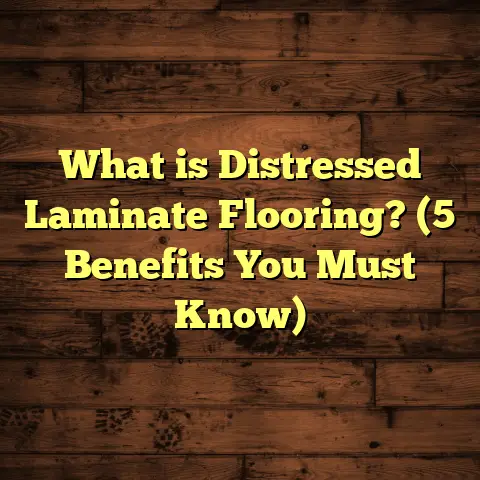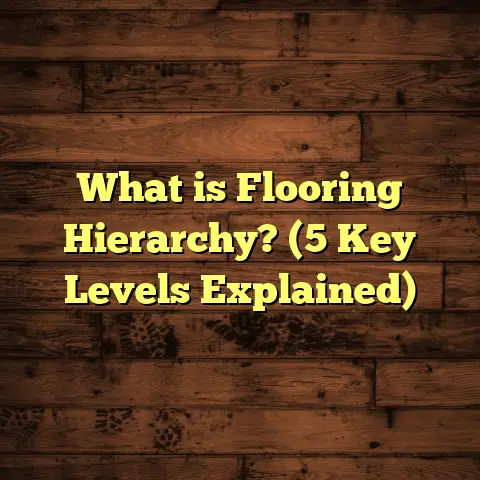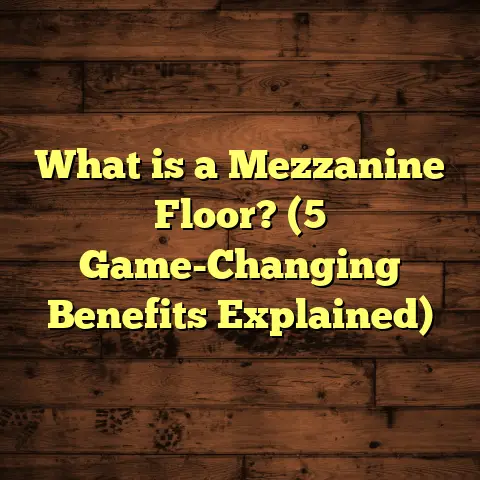What is Cabin Quality Flooring? (5 Essential Features Revealed)
Safety First: Why Flooring Matters More Than You Think
When I first stepped into the world of flooring installation and consultation, safety quickly became my top priority. You might not immediately connect flooring with safety, but trust me—it’s a huge factor. It’s not just about avoiding slips or trips; it’s about creating a foundation that supports your well-being over time.
One of my earliest jobs was in a lakeside cabin where the flooring was so slick when wet that the homeowners were constantly worried about falls. After a small accident involving their child, they called me for help. That experience taught me that cabin floors have to handle unique challenges: moisture, mud, temperature swings, and heavy boots, all while providing a secure footing.
This article isn’t just a lesson in flooring types or materials. I want to share the insights I’ve gained from years of working on cabin floors—from mistakes made and fixed to what really works in real-life conditions. Plus, I’ll give you hands-on tips you can apply if you’re considering flooring for your own cabin.
What Is Cabin Quality Flooring?
At its core, cabin quality flooring is flooring built to withstand the specific demands cabins face. But what does that really mean?
Cabins tend to be located in environments where weather and nature play a big role indoors. Muddy boots, snow, moisture from lakes or rivers, and temperature swings from cold winters to warm summers put extra strain on floors compared to typical city homes. Plus, many cabins embrace a rustic aesthetic that calls for natural textures and finishes.
From my experience helping dozens of cabin owners, I have found cabin quality flooring consistently includes five core features:
- Durability: Able to handle heavy foot traffic and rough use over time without showing damage.
- Moisture resistance: Can endure humidity, water spills, and temperature-driven expansion without warping or mold.
- Ease of maintenance: Simple cleaning routines that fit busy or outdoor-oriented lifestyles.
- Aesthetic fit: A look that complements natural surroundings and rustic design elements.
- Safety underfoot: Slip-resistant surfaces with comfort for standing and walking long periods.
Each of these features is a response to common problems cabin owners face. Let me break these down further with examples and data to help you decide what’s right for your space.
Durable Enough for Rugged Use
If you’re like most cabin owners I work with, you want your floors to last through years of adventures—not crumble after a season or two. Cabins often have guests coming in with hiking boots, kids playing rough, pets running around, and furniture moved frequently.
Here’s a quick story: I once worked on a cabin in Colorado where the owners had initially installed soft pine flooring. Pine looks great with its warm tones but rates quite low on the Janka Hardness Scale (around 420). Within a year, the floor had numerous dents and scratches from boots and pet claws. It was frustrating for them to keep repairing or refinishing.
To fix this, we replaced the pine with engineered hickory, which scores around 1820 on the Janka scale—making it one of the hardest domestic woods available. The difference was night and day. The floors looked almost new even after heavy use for over two years.
Why does hardness matter? The Janka Hardness Test measures how much force it takes to dent wood. Higher numbers mean tougher wood surfaces that resist dents and scratches better. Here are some popular woods used in cabin floors with their Janka ratings for reference:
| Wood Species | Janka Hardness |
|---|---|
| Hickory | 1820 |
| Red Oak | 1290 |
| White Oak | 1360 |
| Maple (Hard) | 1450 |
| Pine (Eastern White) | 420 |
Engineered hardwood also adds durability because it’s built with multiple plywood layers beneath a hardwood veneer. This layered construction resists expansion and contraction better than solid wood alone.
Laminate flooring is another option I’ve seen work well in cabins with heavy traffic. High-quality laminate has a wear layer that protects against scratches and dents. It’s often less expensive than hardwood but can mimic wood visuals convincingly.
Resistance to Moisture and Temperature Changes
Moisture is the enemy of many flooring materials. In cabins near water bodies or in snowy regions, moisture often comes into the home—whether tracked in by boots or from humidity indoors.
I remember a project near a lake where the owners had solid hardwood floors that warped badly after wet boots left puddles near the door. We had to replace several planks within one year. That’s why moisture resistance is crucial.
Engineered Hardwood
Engineered hardwood handles moisture better than solid wood because its plywood base limits swelling and warping. It still needs good sealing around edges and careful installation but holds up much better in damp environments.
Vinyl Plank Flooring (LVP)
Vinyl plank is waterproof and flexible. That means it won’t warp or swell even when exposed to water or changes in temperature. In many cabins I’ve worked on—especially those with kids and pets—vinyl plank flooring near entryways has saved homeowners from expensive repairs.
One lakeside home I recently renovated had vinyl plank throughout the kitchen and mudroom areas. The homeowner said muddy boots tracked in daily didn’t leave stains or damage the floor at all.
Tile Options
Porcelain tile is another moisture-resistant choice, though it can be cold and hard underfoot—something to consider depending on your climate and comfort preferences.
Easy Maintenance for Rustic Living
Cabin life is often busy—filled with outdoor adventures, family gatherings, pets, and dirt. Floors need to handle all that without requiring hours of cleaning every week.
From direct experience, floors with matte or satin finishes hide dust better than shiny surfaces. Glossy finishes tend to show every bit of dirt or smudge clearly.
Practical Cleaning Tips for Cabin Floors:
- Sweep or vacuum regularly with a soft brush attachment.
- Use damp mops rather than soaking wet ones.
- Place mats at entryways to trap dirt before it hits the floor.
- Clean spills immediately to avoid stains or damage.
- Avoid harsh chemicals that can degrade floor finishes.
On one Vermont cabin project, the family had two dogs and kids who tracked in mud daily. We installed textured laminate flooring with scratch-resistant coating. The owners were thrilled that cleanups became quick sweeps or mops without special products.
Visual Appeal That Fits Cabin Style
Cabins often embrace rustic charm—a cozy mix of natural colors, textures, and sometimes reclaimed materials.
I encourage clients to think about texture as much as color when choosing floors. Floors with hand-scraped or distressed finishes add character by hiding small scratches or dents naturally.
I once installed reclaimed barn wood flooring in an Adirondacks cabin that had a story behind every plank. It cost more upfront but gave the home deep authenticity that new materials couldn’t replicate.
Even if you prefer new wood floors, choosing species like hickory or oak with warm tones and varied grain patterns creates that cabin feel.
Safety Underfoot: Slip Resistance and Comfort
Floors can become slippery when wet—or after tracking snow inside—and this is a serious hazard in cabins.
For safety:
- Textured surfaces give better grip.
- Vinyl planks with embossed patterns are great at reducing slips.
- Avoid very smooth hardwood finishes if your cabin gets wet often.
- Consider adding area rugs or mats in key spots like entrances.
Comfort also matters if you spend a lot of time standing inside your cabin cooking or socializing. Floors installed over cork underlayment provide some cushioning that reduces foot fatigue without sacrificing durability.
Data-Backed Insights on Flooring Performance
Let’s look at some numbers from industry research that support what I’ve seen on site:
- Durability: The National Wood Flooring Association reports woods rated above 1300 Janka hardness last twice as long in high-traffic homes compared to softer woods.
- Moisture resistance: Studies show engineered hardwood can reduce moisture-related warping by up to 75% versus solid hardwood.
- Maintenance: Consumer Reports ranks vinyl plank flooring as the easiest to clean and most stain-resistant among popular options.
- Safety: Slip resistance tests show embossed vinyl reduces slip incidents by up to 40% compared to smooth hardwood finishes.
These stats confirm why many cabin owners are choosing engineered hardwood or vinyl plank over traditional solid wood these days.
My Personal Take: Lessons From Real Projects
Early in my career, I made plenty of mistakes recommending floors based on looks alone. One client loved the idea of classic pine floors for their Vermont cabin because it matched their vision perfectly.
But a few months later, they called me frustrated by scratches from boots and pet nails—and worse yet, water damage near the back door during spring thaw.
Since then, I ask more questions about how clients live in their cabins:
- Do you have pets? What kind?
- How often do you track in snow or mud?
- Do you prefer natural wood look or are you open to modern alternatives like vinyl?
- How much time can you realistically spend cleaning?
This way I can suggest floors that fit both lifestyle and environment—and save clients money on repairs later.
Practical Tips for Choosing Cabin Quality Flooring
Here are some tips I wish someone told me when I started installing cabin floors:
Test Samples at Home
Don’t just look at samples under store lights; bring them home. See how they look in your cabin’s natural lighting at different times of day—and walk on them wearing your usual shoes or boots.
Factor Waste Into Your Budget
Cutting planks to fit corners or around chimneys means extra material is needed. Add 5-10% more flooring to your order to cover waste and future repairs.
Use Suitable Underlayment
Underlayment improves comfort underfoot, reduces noise, insulates against cold floors, and can protect against minor moisture intrusion.
Seal Edges Thoroughly
Especially near doors or kitchens where water exposure is higher, seal edges well with urethane or special floor sealants.
Hire Professionals When Needed
Some materials like engineered hardwood require precise installation techniques for long-term success. Mistakes cause gaps or buckling later on.
Case Study: A Mountain Cabin Success Story
Last winter, I helped a family in Montana who wanted durable yet cozy floors for their mountain retreat.
We chose engineered hickory planks finished matte with hand-scraped texture for character. Cork underlayment added warmth and sound absorption. The floor was installed with tight seams using moisture-resistant adhesive.
After one snowy season packed with muddy boots and sledding gear tracked inside daily? No warping, no deep scratches beyond normal wear—and cleanup was simple sweeping or quick mopping.
The owners told me this was their best investment yet because their floor looked great without constant worry about damage.
Breaking Down Costs For Cabin Flooring Choices
Budgeting can be tricky since prices vary widely by material quality, installation complexity, and region.
Here’s a rough breakdown based on real projects:
| Material | Average Cost per sq.ft (Materials + Installation) |
|---|---|
| Solid Pine Hardwood | $6 – $12 |
| Engineered Hardwood | $7 – $14 |
| Laminate Flooring | $3 – $7 |
| Luxury Vinyl Plank | $4 – $9 |
| Porcelain Tile | $8 – $15 |
Keep in mind: higher upfront cost for durable engineered wood or vinyl often pays off by avoiding repairs later.
Final Thoughts To Keep You Moving Forward
Choosing cabin quality flooring means balancing durability, moisture resistance, maintenance ease, aesthetic fit, and safety—all tailored to how you live in your space.
I’ve learned through years of installation, repairs, and client conversations that it pays off to think beyond looks alone—your floor supports your home physically and emotionally.
If you want my help selecting brands or materials tailored to your climate or budget, just ask!
What challenges have you faced with your cabin floors? Or what worked well? Sharing stories helps us all make better choices next time around!





